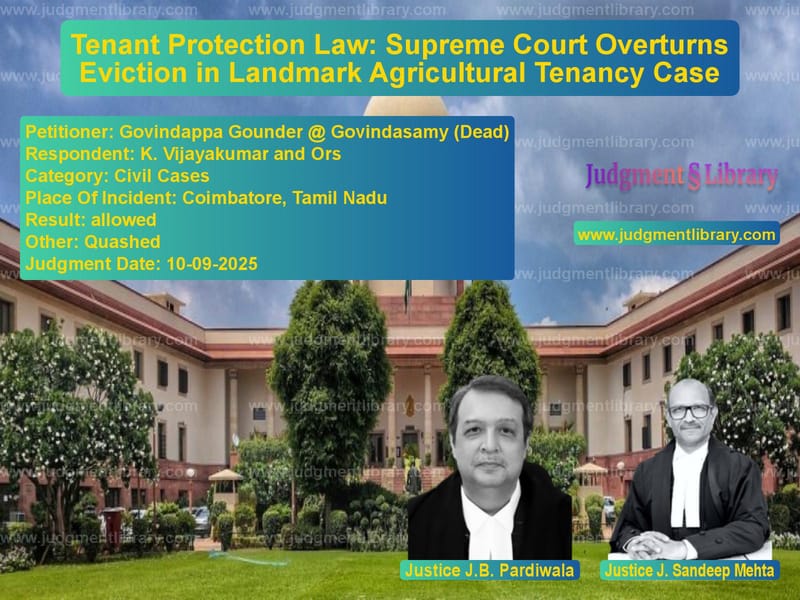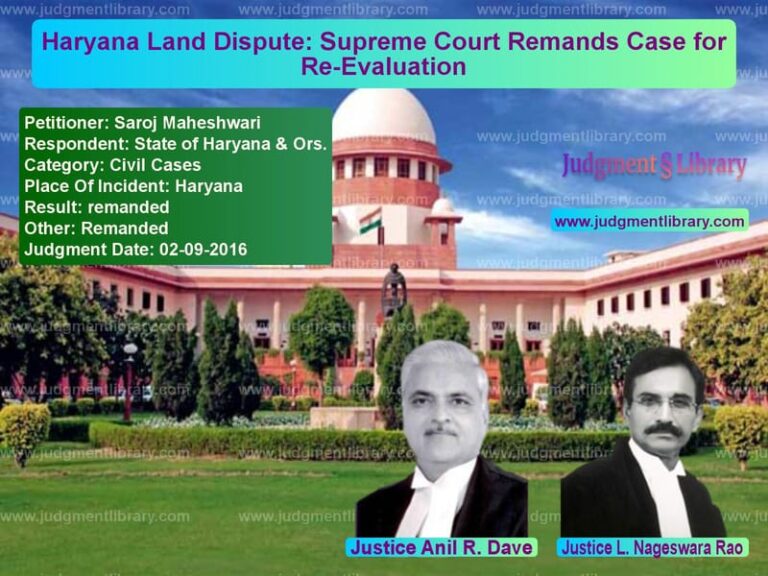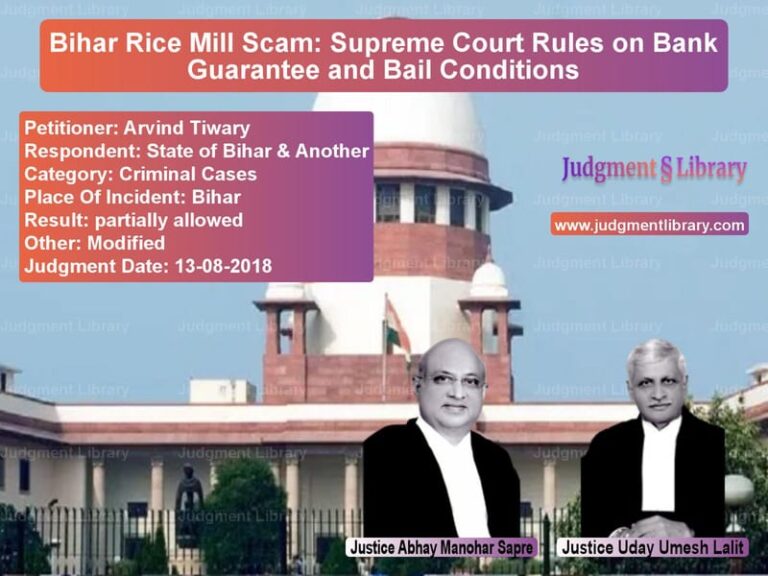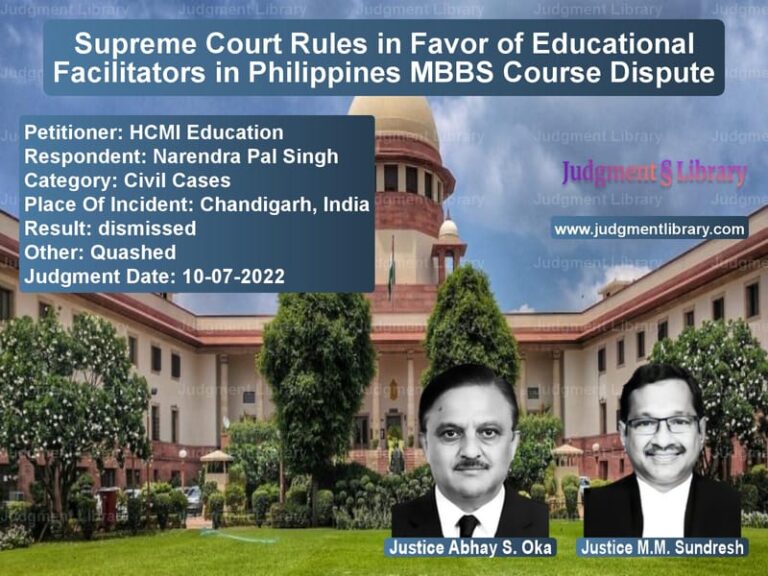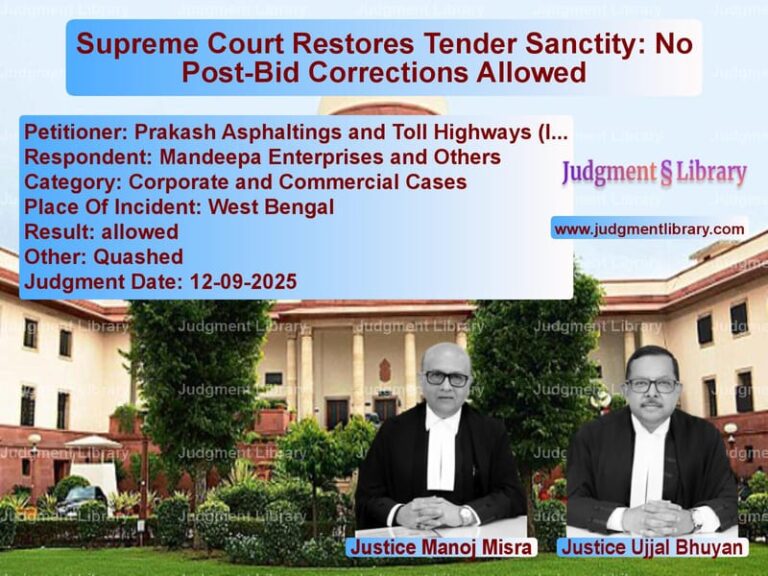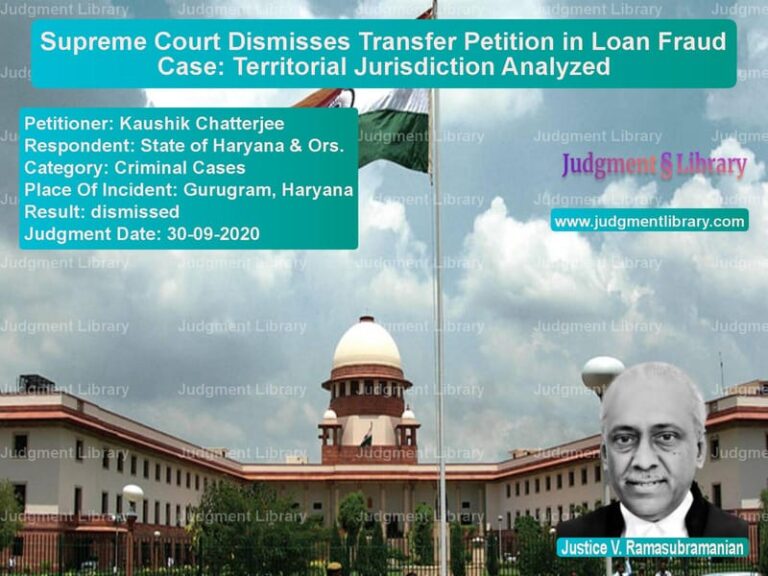Tenant Protection Law: Supreme Court Overturns Eviction in Landmark Agricultural Tenancy Case
In a significant ruling that reinforces the protective intent of tenancy laws, the Supreme Court of India recently delivered a judgment that safeguards the rights of agricultural tenants against arbitrary eviction. The case of Govindappa Gounder versus K. Vijayakumar and Others represents a classic legal battle between landowners seeking to reclaim their property and tenants fighting to protect their livelihood, all unfolding over agricultural land in Coimbatore, Tamil Nadu.
The dispute centered around approximately 7 acres of agricultural land in Village Pichanoor, Taluk Coimbatore South, where the appellant’s family had been cultivating since the 1950s. What began as a simple tenancy arrangement evolved into a complex legal saga spanning multiple courts and lasting over three decades, highlighting the challenges faced by agricultural tenants in India’s legal system.
The legal journey began in 1993 when Govindappa Gounder, the original appellant who has since passed away, filed Original Suit No. 1363/1993 seeking permanent injunction to prevent the landowners from interfering with his possession and cultivation of the subject land. The trial court ruled in his favor, decreeing that “the land owners shall not disturb or interfere with the lawful possession of the tenant except in accordance with law.” This decision was subsequently upheld in appeal, establishing his legal right to cultivate the land.
However, parallel legal proceedings were unfolding simultaneously. The landowners filed Original Suit No. 491/1994, alleging that the tenant had caused damage to the property by cutting trees and digging pits. They sought permanent injunction to prevent further damage and claimed compensation for the alleged losses. The two suits were consolidated since they involved the same parties and related issues, and common evidence was recorded.
In this second suit, the trial court initially ruled in favor of the landowners, but the first appellate court reversed this decision, setting aside the judgment and decree. Not satisfied with this outcome, the landowners approached the High Court through a second appeal, which ruled in their favor, restoring the original trial court decree.
The legal battle took a crucial turn when the landowners initiated proceedings under the Tamil Nadu Cultivating Tenants Protection Act, 1955. They filed Original Petition No. 16/2001 before the Assistant Commissioner, Revenue Court, Tiruchirapalli, seeking eviction of the tenant on grounds that he had caused damage to the suit land by felling trees and other destructive activities.
The Revenue Court, relying heavily on a Commissioner’s report from the civil court proceedings, ordered the eviction of the tenant. In its order dated November 21, 2008, the Revenue Court observed: “Ex.P.2 Court Commissioner, in his Report stated that trees and branches were cut down and pits also dug up in the lands. In Ex.P.3 District Munsif Courts order also it is found that the trees and branches were cut off and pits were dug up. Hence, the respondent has dug up the pits and cut down the trees and branches is proved. The respondent without cultivating the lands. Since cut down the trees and branches has caused damages to the land is proved. The Respondents were given the property for cultivation only. Since he has committed damages without cultivating lands he cost the tenancy rights and therefore losing the right as tenant.”
The core legal issue revolved around the interpretation of Section 3(2)(b) of the Tamil Nadu Cultivating Tenants Protection Act, 1955. This provision states that the general protection against eviction “shall not apply to a cultivating tenant… (b) Who has done any act or has been guilty of any negligence which is destructive of, or injurious to, the land or any crop thereon or has altogether ceased to cultivate the land.”
The appellants challenged the Revenue Court’s order through a civil revision petition in the High Court, which was heard together with the second appeal and dismissed through a common order. This led to the Supreme Court appeal by the legal heirs of the original tenant.
Before the Supreme Court, the legal arguments centered on whether there was sufficient evidence to establish that the tenant had engaged in activities destructive or injurious to the land, thus warranting eviction under the protective legislation.
The Supreme Court, in its analysis, made several crucial observations about the nature of protective tenancy legislation. The court emphasized that “The Act 1955 was enacted solely to protect the interest of the cultivating tenants. In other words, the object in enacting the said Act was to protect the cultivating tenants from forcible dispossession by the landlords. In such circumstances, the provisions of the Act should also be interpreted accordingly. In other words, the provisions should be interpreted in such a manner that the tenants are ultimately protected and are not thrown out at the instance of the landlords who are always interested to see that the tenants leave.”
The court further elaborated on the principle of beneficial construction, stating: “Beneficent construction involves giving the widest meaning possible to the statutes. When there are two or more possible ways of interpreting a section or a word, the meaning which gives relief and protects the benefits which are purported to be given by the legislation, should be chosen. A beneficial statute has to be construed in its correct perspective so as to fructify the legislative intent. The Act, 1955 seeks to protect cultivating tenants from unjust evictions and it is a cardinal principle of law that in case of doubt, such Acts should be interpreted to lean in favour of tenants.”
In its critical assessment of the evidence, the Supreme Court found that “there is nothing to indicate that the appellants were negligent in any manner or had done any act by which they could be said to have caused damage to the suit land or could be said to have done something, which could be said to be injurious to the land or any crop thereon.” The court noted the long-standing relationship between the tenant and the land, observing that “the appellants had been cultivating the suit land since 1955-1960. They would be more concerned or interested to protect the land, more particularly their crops they cultivate.”
The judgment particularly criticized the mechanical approach of the lower courts, noting that “the Revenue Court mechanically relied upon the Commissioner’s report and passed the order of eviction. The High Court also in exercise of its revisional jurisdiction under Section 115 of the Code of Civil Procedure, 1908, affirmed the order in a very slipshod manner passed by the Revenue Court.”
The Supreme Court established an important legal standard for eviction cases under protective tenancy legislation, ruling that “It is only when there is cogent, credible and reliable evidence on record of gross violation of the provisions of Section 3(2)(b) of the Act 1955 that the Revenue Court may be justified in ordering eviction of the tenant under the Act 1955.”
In its concluding remarks, the court warned against judicial approaches that undermine legislative intent, stating: “The enactments like the Act 1955 are really meant for the purposes proclaimed by them. The obvious effect of such statutory provisions cannot be taken away or whittled down by forensic sophistry. Courts should not allow themselves to become tools for defeating clearly expressed statutory intentions.”
The Supreme Court ultimately allowed the appeals, setting aside the High Court’s order and consequently the Revenue Court’s eviction order. The court directed that “the respondents shall not interfere with the possession of the appellants, save and except in accordance with law.”
This judgment represents a significant reinforcement of tenant protection principles in Indian jurisprudence. By emphasizing the need for cogent and reliable evidence of substantial damage before ordering eviction, and by reiterating the principle of beneficial construction for protective legislation, the Supreme Court has provided crucial safeguards for agricultural tenants across the country.
The ruling also serves as an important reminder to lower courts about their responsibility to carefully examine evidence rather than relying mechanically on reports, and to always consider the protective intent behind social welfare legislation. For thousands of agricultural tenants in Tamil Nadu and beyond, this judgment reaffirms their legal protections and ensures that their livelihoods cannot be arbitrarily taken away through questionable eviction proceedings.
As agricultural tenancy continues to be a vital aspect of India’s rural economy, this Supreme Court ruling will likely serve as a precedent for future cases involving the interpretation of protective tenancy legislation, ensuring that the balance between landowners’ rights and tenants’ protections is maintained in accordance with legislative intent and principles of justice.
Petitioner Name: Govindappa Gounder @ Govindasamy (Dead).Respondent Name: K. Vijayakumar and Ors.Judgment By: Justice J.B. Pardiwala, Justice J. Sandeep Mehta.Place Of Incident: Coimbatore, Tamil Nadu.Judgment Date: 10-09-2025.Result: allowed.
Don’t miss out on the full details! Download the complete judgment in PDF format below and gain valuable insights instantly!
Download Judgment: govindappa-gounder-@-vs-k.-vijayakumar-and-o-supreme-court-of-india-judgment-dated-10-09-2025.pdf
Directly Download Judgment: Directly download this Judgment
See all petitions in Property Disputes
See all petitions in Landlord-Tenant Disputes
See all petitions in Judgment by J.B. Pardiwala
See all petitions in Judgment by Sandeep Mehta
See all petitions in allowed
See all petitions in Quashed
See all petitions in supreme court of India judgments September 2025
See all petitions in 2025 judgments
See all posts in Civil Cases Category
See all allowed petitions in Civil Cases Category
See all Dismissed petitions in Civil Cases Category
See all partially allowed petitions in Civil Cases Category

